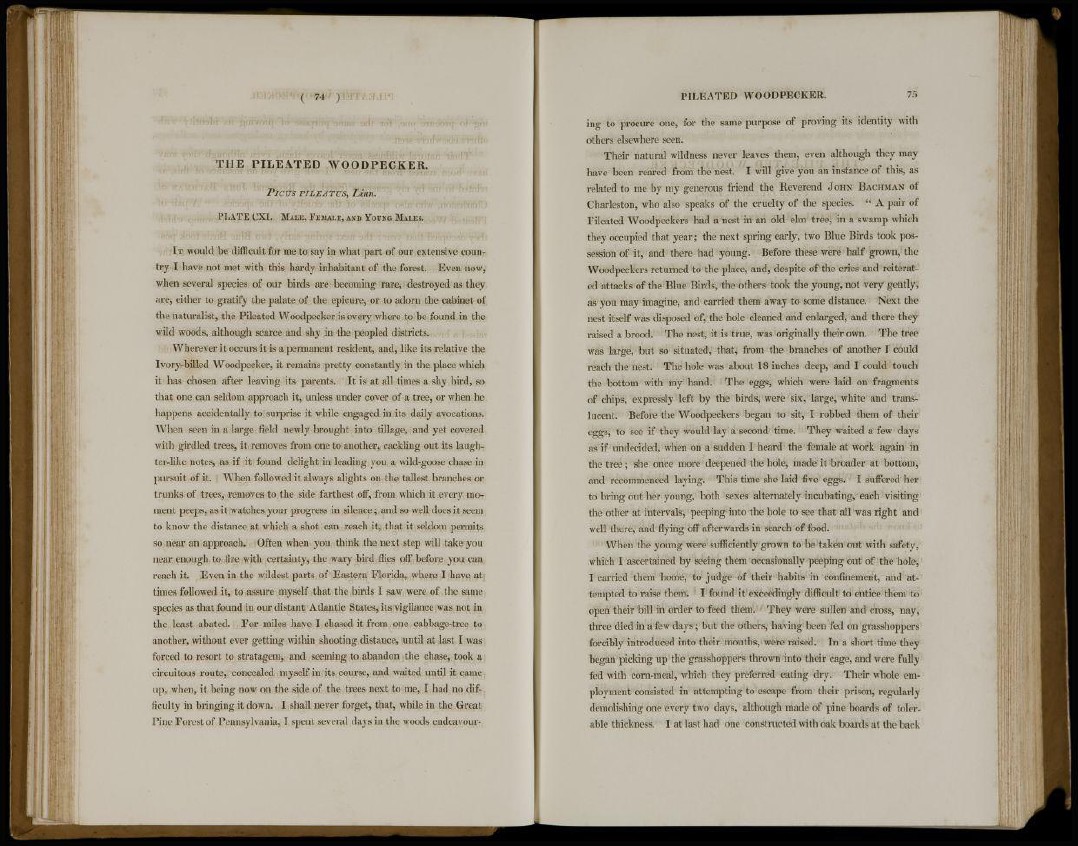
( 74 )
T H E P I L E A T E D WOODPECKER.
Pic us PILEATUS, Linn.
P L A T E C X I . MALE, FEMALE, AND YOUNG MALES.
IT would be difficult for me to say in what part of our extensive country
I have not met with this hardy inhabitant of the forest. Even now,
when several species of our birds are becoming rare, destroyed as they
are, either to gratify the palate of the epicure, or to adorn the cabinet of
the naturalist, the Pileated Woodpecker is every where to be found in the
wild woods, although scarce and shy in the peopled districts.
Wherever it occurs it is a permanent resident, and, like its relative the
Ivory-billed Woodpecker, it remains pretty constantly in the place which
it has chosen after leaving its parents. It is at all times a shy bird, so
that one can seldom approach it, unless under cover of a tree, or when he
happens accidentally to surprise it while engaged in its daily avocations.
When seen in a large field newly brought into tillage, and yet covered
with girdled trees, it removes from one to another, cackling out its laughter
like notes, as if it found delight in leading you a wild-goose chase in
pursuit of it. When followed it always alights on the tallest branches or
trunks of trees, removes to the side farthest off, from which it every moment
peeps, as it watches your progress in silence; and so well does it seem
to know the distance at which a shot can reach it, that it seldom permits
so near an approach. Often when you think the next step will take you
near enough to fire with certainty, the wary bird flies off before you can
reach it. Even in the wildest parts of Eastern Florida, where I have at
times followed it, to assure myself that the birds I saw were of the same
species as that found in our distant Atlantic States, its vigilance was not in
the least abated. For miles have I chased it from one cabbage-tree to
another, without ever getting within shooting distance, until at last I was
forced to resort to stratagem, and seeming to abandon the chase, took a
circuitous route, concealed myself in its course, and waited until it came
up, when, it being now on the side of the trees next to me, I had no difficulty
in bringing it down. I shall never forget, that, while in the Great
Pine Forest of Pennsylvania, I spent several days in the woods endeavour-
PILEATED WOODPECKER. 75
irig to procure one, for the same purpose of proving its identity with
others elsewhere seen.
Their natural wildness never leaves them, even although they may
have been reared from the nest. I will give you an instance of this, as
related to me by my generous friend the Reverend JOHN BACHMAN of
Charleston, who also speaks of the cruelty of the species. " A pair of
Fileated Woodpeckers had a nest in an old elm tree, in a swamp which
they occupied that year; the next spring early, two Blue Birds took possession
of it, and there had young. Before these were half grown, the
Woodpeckers returned to the place, and, despite of the cries and reiterated
attacks of the Blue Birds, the others took the young, not very gently,
as you may imagine, and carried them away to some distance. Next the
nest itself was disposed of, the hole cleaned and enlarged, and there they
raised a brood. The nest, it is true, was originally their own. The tree
was large, but so situated, that, from the branches of another I could
reach the nest. The hole was about 1 8 inches deep, and I could touch
the bottom with my hand. The eggs, which were laid on fragments
of chips, expressly left by the birds, were six, large, white and translucent.
Before the Woodpeckers began to sit, I robbed them of their
eggs, to see if they would lay a second time. They waited a few days
as if undecided, when on a sudden I heard the female at work again in
the tree; she once more deepened the hole, made it broader at bottom,
and recommenced laying. This time she laid five eggs. I suffered her
to bring out her young, both sexes alternately incubating, each visiting
the other at intervals, peeping into the hole to see that all was right and
well there, and flying off afterwards in search of food.
When the young were sufficiently grown to be taken out with safety,
which I ascertained by seeing them occasionally peeping out of the hole,
I carried them home, to judge of their habits in confinement, and attempted
to raise them. I found it exceedingly difficult to entice them to
open their bill in order to feed them. They were sullen and cross, nay,
three died in a few days; but the others, having been fed on grasshoppers
forcibly introduced into their mouths, were raised. In a short time they
began picking up the grasshoppers thrown into their cage, and were fully
fed with corn-meal, which they preferred eating dry. Their whole employment
consisted in attempting to escape from their prison, regularly
demolishing one every two days, although made of pine boards of tolerable
thickness. I at last had one constructed with oak boards at the back